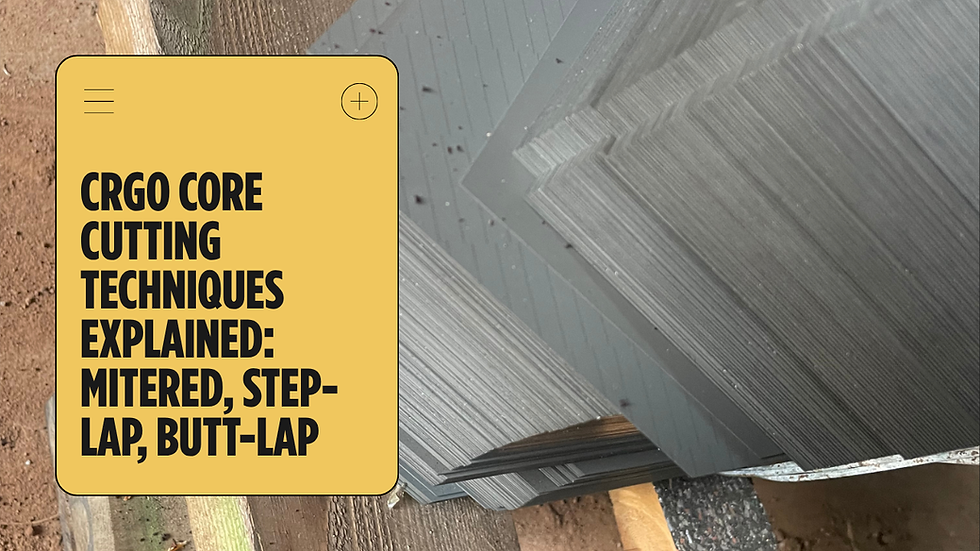Why the CRGO Steel Market is Down Right Now: Key Insights for September 2025
- mukesh muke
- Sep 17
- 4 min read

Introduction
At S M Steels, we’ve observed a noticeable softening in CRGO (Cold Rolled Grain Oriented) steel prices and demand across India in September 2025. For many businesses—transformer manufacturers, distributors, and buyers—this downturn raises questions: Why is this happening now? Is this temporary? What should we expect next?
In this blog, we analyse factual, up-to-date data and trends that are behind the current market dip. Understanding these factors will help you make smarter purchasing or inventory decisions in these uncertain times.
What the Data Shows
Imports are falling sharply
In August 2025, steel imports into India declined by approximately 31%. SteelOrbis
At the same time, exports rose by about 54%, though India remains a net steel importer. SteelOrbis
Policy / regulation tightening for steel input quality
The Indian government has introduced stricter rules requiring imported input materials (slabs, billets, etc.) to comply with BIS (Bureau of Indian Standards) norms, not just the finished product. Argus Media
Such rules reduce import flexibility and can delay shipments or increase cost for non-compliant imports. Argus Media
Weak demand & seasonal slowdown
The monsoon period in India traditionally slows down construction activity, which in turn softens demand for steel products (flat/coil sheets, HRC, etc.). Policy Circle+1
Domestic industries such as construction, infrastructure, consumer appliances—major users of transformer cores—are showing slower order inflow. Leads are not converting into purchases as quickly. Policy Circle
Pressure from cheap imports, especially Chinese steel
Steel from China sold at discount prices has entered the Indian market, pushing down local pricing. Reuters+2Policy Circle+2
Indian steel mills are pressing for safeguard measures (temporary taxes or duties) to counter these imports. Reuters+2Policy Circle+2
Margins under pressure for steel producers
Falling prices for Hot Rolled Coils (HRC) and other steel inputs are squeezing margins. For many producers, input costs (iron ore, coal, etc.) remain high while selling prices slide. The Times of India+3Policy Circle+3Reuters+3
Because CRGO is a specialized steel grade, the impact is magnified by added cost of production, quality testing, and import constraints.
How These Trends Affect CRGO Specifically
CRGO being a specialty steel material for transformers and electrical applications experiences the impact of the above more sharply in several ways:
Reduced demand from industries that depend on stable, long-term procurement (power utilities, transformer manufacturers), which become cautious amid price volatility and policy changes.
Import delays or higher costs for CRGO inputs due to new quality control rules (BIS compliance) — non-compliant shipments may be rejected or delayed.
Suppliers may cut prices or offer discounts to move inventory, lowering market price benchmarks for CRGO materials (coils, laminations).
Buyers postponing purchases expecting prices to fall further, which further weakens spot demand.
What This Means for Buyers & Distributors
If you are a buyer of CRGO steel (transformer manufacturer, distributor, etc.), or a seller like S M Steels, here are some practical implications and strategies:
Situation | Implication | Suggested Action |
Declining CRGO spot prices | You may be able to negotiate better purchase terms or delay procurement a little if you have flexibility. | Lock in favorable quotes now for future deliveries; consider buying in smaller lots to reduce risk. |
Uncertain import quality / delays | Risk of paying for non-compliant material, or having your project delayed. | Always verify BIS-certified suppliers; request documentation; do sample testing. |
Market oversupply & buyer caution | Leads may drop; some buyers may delay orders. | Keep strong relationships with clients; offer flexible payment or delivery terms; highlight quality/durability advantages. |
Margins squeezed for suppliers | Profit margins may reduce; inventory holding costs rise. | Reduce holding cost; optimize stock; try sourcing from lower import cost channels that meet quality; highlight cost-per-performance to buyers. |
Outlook: What to Watch Next
To predict when the CRGO market might recover or stabilise, watch these indicators:
Policy updates — Look for any final decisions on safeguard duties, new import-quality rules, or tax changes on steel imports.
Import data — Monthly and quarterly steel import/export volumes. A sustained drop in cheap imports could ease pressure.
Infrastructure & transformer tenders — Government investment in power, grid upgrades, EV charging, renewable integration. New transformer orders will drive CRGO demand.
Raw material cost moves — Costs of silicon steel inputs, electricity, and steel-making energy. If those drop, cost pressure eases.
Seasonal demand changes — Post-monsoon / winter months usually see pickup in construction and industrial activity.
Conclusion
The current downturn in the CRGO steel market is being driven by a mix of import pressure, regulatory tightening, seasonal demand softening, and falling steel input prices. While some of these are short-term (monsoon, seasonal lag), others (policy, imports) are structural and likely to shape the market for months ahead.
For businesses involved in CRGO—both buyers and suppliers—it’s a time for caution, smart negotiation, rigorous quality control, and flexible procurement strategies. At S M Steels, we are monitoring these trends closely, ensuring that our CRGO coil and lamination supplies meet the required standards, and offering steady reliability despite market volatility.







Comments